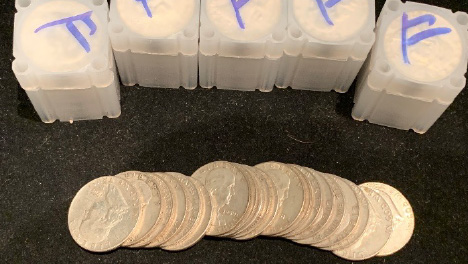The U.S. half dollar is a coin that has been in circulation since 1794. It is currently one of the least commonly used coins in the United States. The half dollar is made of a copper-nickel blend, but it has been made of other materials in the past, including silver and copper. All half dollars from 1964 or earlier are 90% silver, from 1965-1970 they contain 40% silver.
The first half dollar was minted in 1794 and featured the “Flowing Hair” design, which depicted a portrait of Liberty with her hair flowing on the obverse, and an eagle on the reverse. The half dollar was originally made of silver and was valued at one-half of a dollar. Very rare coin is sought after but also very expensive.
In 1796, the design of the half dollar was changed to feature the “Draped Bust” design, which showed Liberty with a draped bust on the obverse, and an eagle on the reverse. This design was used until 1807, when it was replaced by the “Capped Bust” design, which depicted Liberty with a cap on the obverse, and an eagle on the reverse. Also a very rare and expensive half dollar coveted by collectors.
The “Seated Liberty” design was introduced in 1839 and remained in use until 1891. This design depicted Liberty seated on a rock with a shield at her side and a branch in her hand on the obverse, and an eagle on the reverse. In 1892, the design was changed again with the introduction of the “Barber” design, which featured Liberty with a Phrygian cap on the obverse, and an eagle on the reverse.
In 1892 the mint issued a new design by Charles Barber, The Barber half dollar series was minted from 1892 to 1915 and has several key dates that are highly sought after by collectors. Key date Barber half dollars:
- 1892-O: This is the first year of issue for the Barber half dollar and has a low mintage of only 390,000 coins. It is quite rare and valuable in any grade.
- 1892-S: This coin has a mintage of only 1.2 million and is considered rare, particularly in higher grades.
- 1893-S: This date has a mintage of only 1.4 million and is considered rare, especially in higher grades.
- 1895: This date is a proof-only issue and has a mintage of only 880 coins. It is extremely rare and valuable.
- 1904-S: This coin has a mintage of only 553,038 and is considered rare, particularly in higher grades.
In 1916, the design of the half dollar was changed once again with the introduction of the “Walking Liberty” design, which features Liberty walking toward the rising sun on the obverse, and an eagle on the reverse. This design proved to be very popular and was used until 1947. These coins are the fan favorite for early bullion collectors as you can obtain them in bulk, and they are generally more desired than the Franklins. With that said some people love the Franklin and prefer to collect them.
In 1948, the U.S. Mint introduced the “Franklin” half dollar, which features a portrait of Benjamin Franklin on the obverse and the Liberty Bell on the reverse. This design was used until 1963, when it was replaced by the “Kennedy” half dollar, which features a portrait of President John F. Kennedy on the obverse, and an adaptation of the Presidential seal on the reverse. Only the first year of issue 1964 Kennedy is 90% silver, after that 1965-1970 they contain 40% silver and after 1970 they do not contain silver.
